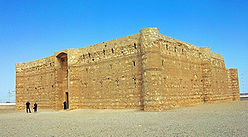
Harrana
Encyclopedia
Harrana, named after Qasr Kharana
, an archeological Umayyad
desert palace in the area, is part of the Jordan eastern plateau some 60 kilometers southeast of Amman
city.
 .
.
The area is largely uninhabited except for seasonal bedouin
sheep and camel herders who bring their livestock to the area during the months of December through April.
Harrana's climate, much like the other parts of the country, is influenced by the moderate Mediterranean climate
from the west, the very hot Sahara
's climate from the east, and the cold European climate from the north.
Though arid, the area is rich in animal life. Birds, owls, rodents, rabbits, foxes, occasional wolves and hyenas, snakes, and lizards are some of the animals that take refuge in Harrana. A variety of flowering plants bloom during late winter-early spring months including mustard plants, oriental popies, and wild irisis. Cistanche tubulosa, or the desert broomrape, is also another beautiful resident in Harrana blooming towards the end of spring and beginning of summer.
Harrana is significant for its fossils deposits preserved in gigantic limestone concretions that date back to the latest Maastrichtian some 66-67 million years ago, a period notably close to the end Cretaceous extinction events when many groups of animals such as dinosaurs and pterosaurs and as much as 65-70% of all marine animal species became extinct. Mosasaur specimens along with their remarkably well preserved scale imprints have been discovered from late Maastricht
ian deposits of the Muwaqqar Chalk Marl Formation of Harrana
The best preserved and complete specimens of the extinct teleostean fish genus Saurocephalus
and the most complete mosasaur Carinodens remains come from the latest Maastrichtian of Harrana.
Qasr Kharana
Qasr Kharana , sometimes Qasr al Harrana, Qasr al Kharanah, Kharaneh or Hraneh, is one of the best-known of the desert castles located in present-day eastern Jordan, about east of Amman and relatively close to the border with Saudi Arabia...
, an archeological Umayyad
Umayyad
The Umayyad Caliphate was the second of the four major Arab caliphates established after the death of Muhammad. It was ruled by the Umayyad dynasty, whose name derives from Umayya ibn Abd Shams, the great-grandfather of the first Umayyad caliph. Although the Umayyad family originally came from the...
desert palace in the area, is part of the Jordan eastern plateau some 60 kilometers southeast of Amman
Amman
Amman is the capital of Jordan. It is the country's political, cultural and commercial centre and one of the oldest continuously inhabited cities in the world. The Greater Amman area has a population of 2,842,629 as of 2010. The population of Amman is expected to jump from 2.8 million to almost...
city.

The area is largely uninhabited except for seasonal bedouin
Bedouin
The Bedouin are a part of a predominantly desert-dwelling Arab ethnic group traditionally divided into tribes or clans, known in Arabic as ..-Etymology:...
sheep and camel herders who bring their livestock to the area during the months of December through April.
Harrana's climate, much like the other parts of the country, is influenced by the moderate Mediterranean climate
Mediterranean climate
A Mediterranean climate is the climate typical of most of the lands in the Mediterranean Basin, and is a particular variety of subtropical climate...
from the west, the very hot Sahara
Sahara
The Sahara is the world's second largest desert, after Antarctica. At over , it covers most of Northern Africa, making it almost as large as Europe or the United States. The Sahara stretches from the Red Sea, including parts of the Mediterranean coasts, to the outskirts of the Atlantic Ocean...
's climate from the east, and the cold European climate from the north.
Though arid, the area is rich in animal life. Birds, owls, rodents, rabbits, foxes, occasional wolves and hyenas, snakes, and lizards are some of the animals that take refuge in Harrana. A variety of flowering plants bloom during late winter-early spring months including mustard plants, oriental popies, and wild irisis. Cistanche tubulosa, or the desert broomrape, is also another beautiful resident in Harrana blooming towards the end of spring and beginning of summer.
Harrana is significant for its fossils deposits preserved in gigantic limestone concretions that date back to the latest Maastrichtian some 66-67 million years ago, a period notably close to the end Cretaceous extinction events when many groups of animals such as dinosaurs and pterosaurs and as much as 65-70% of all marine animal species became extinct. Mosasaur specimens along with their remarkably well preserved scale imprints have been discovered from late Maastricht
Maastricht
Maastricht is situated on both sides of the Meuse river in the south-eastern part of the Netherlands, on the Belgian border and near the German border...
ian deposits of the Muwaqqar Chalk Marl Formation of Harrana
The best preserved and complete specimens of the extinct teleostean fish genus Saurocephalus
Saurocephalus
Saurocephalus is an extinct genus of fishes within the family Saurodontidae Cope, 1871.Members of this family were teleostean fishes restricted to the upper Cretaceous...
and the most complete mosasaur Carinodens remains come from the latest Maastrichtian of Harrana.

